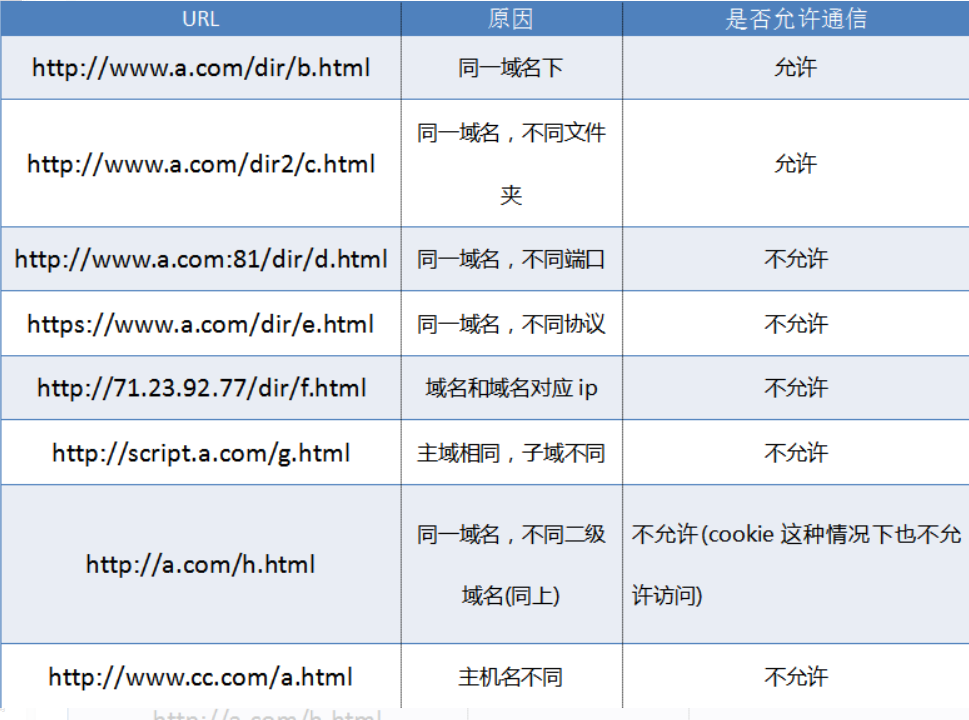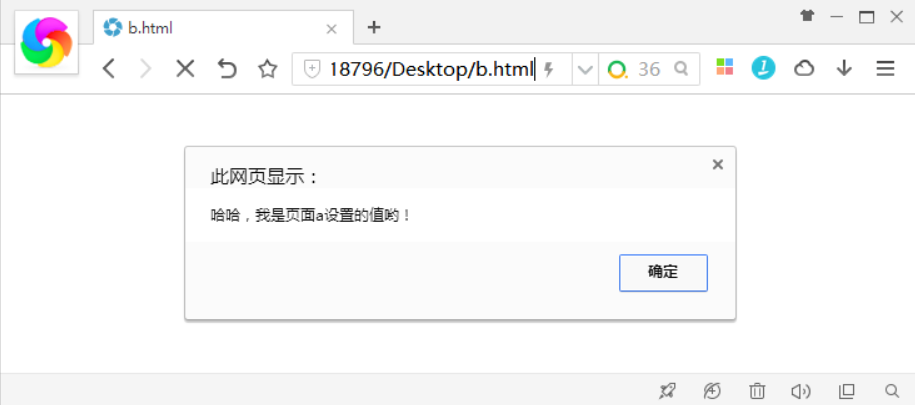这里说的js跨域是指通过js在不同的域之间进行数据传输或通信,比如用ajax向一个不同的域请求数据,或者通过js获取页面中不同域的框架中(iframe)的数据。只要协议、域名、端口有任何一个不同,都被当作是不同的域。

特别注意两点:
#1、如果是协议和端口造成的跨域问题“前台”是无能为力的;
#2、在跨域问题上,域仅仅是通过“URL的首部”来识别而不会去尝试判断相同的ip地址对应着两个域或两个域是否在同一个ip上。
要解决跨域的问题,我们可以使用以下几种方法:
方法一、通过jsonp跨域
JSONP包含两部分:回调函数和数据。
回调函数:当响应到来时要放在当前页面被调用的函数。
数据:就是传入回调函数中的json数据,也就是回调函数的参数了。
/*handleResonse({"data": "zhe"})*///原理如下://当我们通过script标签请求时//后台就会根据相应的参数(json,handleResponse)//来生成相应的json数据(handleResponse({"data": "zhe"}))//最后这个返回的json数据(代码)就会被放在当前js文件中被执行//至此跨域通信完成//1、使用JS动态生成script标签,进行跨域操作function handleResponse(response){ console.log('The responsed data is: '+response.data); //处理获得的Json数据}var script = document.createElement('script');script.src = 'http://www.example.com/data/?callback=handleResponse';document.body.insertBefore(script, document.body.firstChild);--------------------------//2、手动生成script标签function handleResponse(response){ console.log('The responsed data is: '+response.data); //处理获得的Json数据}<script src="http://www.example.com/data/?callback=handleResponse"></script>--------------------------//3、使用jQuery进行jsonp操作//jquery会自动生成一个全局函数来替换callback=?中的问号,之后获取到数据后又会自动销毁//$.getJSON方法会自动判断是否跨域,不跨域的话,就调用普通的ajax方法;跨域的话,则会以异步加载js文件的形式来调用jsonp的回调函数。<script> $.getJson('http://www.example.com/data/?callback=?',function(jsondata){ //处理获得的Json数据});</script>jsonp虽然很简单,但是有如下缺点:
#1)安全问题(请求代码中可能存在安全隐患)#2)要确定jsonp请求是否失败并不容易
方法二、通过document.domain+iframe来跨子域(只有在主域相同的时候才能使用该方法)
浏览器同源策略限制:
#(1)不能通过ajax的方法去请求不同源中的文档。#(2)浏览器中不同域的框架之间是不能进行js的交互操作的。
所以,在不同的框架之间(父子或同辈),是能够获取到彼此的window对象的,但不能使用获取到的window对象的属性和方法(html5中的postMessage方法是一个例外),总之,你可以当做是只能获取到一个几乎无用的window对象。
例如,在一个页面 http:// www.example.com/a.html 中,有一个iframe框架它的src是http:// example.com/b.html, 很显然,这个页面与它里面的iframe框架是不同域的,所以我们是无法通过在页面中书写js代码来获取iframe中的东西的:
1 // http://www.example.com/a.html 页面中 2 <script> 3 function onLoad(){ 4 var iframe = document.getElementById('iframe'); 5 var win = iframe.contentWindow; 6 //这里能够获取到iframe中的window对象,但是window对象的属性和方法几乎不可用。 7 var doc = win.document;//这里获取不到iframe中的document对象 8 var name = win.name;//这里获取不到window对象的name属性 9 ······10 }11 <iframe id = "iframe" src ="http:// example.com/b.html" onload = "onLoad()"></iframe> 所以我们就要用到document.domain
1) 在页面http:// www.a.com/dir/a.html中设置document.domain:
1 <iframe src = "http://script.a.com/dir/b.html" id="iframe" onload = "loLoad()"></iframe>2 <script>3 document.domain = "a.com";//设置成主域4 function test(){5 var iframe = document.getElementById("iframe");6 var win = iframe.contentWindow;7 //在这里就可以操作b.html8 }9 </script>2) 在http:// script.a.com/dir/b.html也需要显示的设置document.domain
1 <script>2 document.domain = "a.com";3 </script>
注意,document.domain的设置是有限制的:
我们只能把document.domain设置成自身或更高一级的父域,且主域必须相同。
例如:a.b.c.com 中某个文档的document.domain 可以设成a.b.c.com、b.c.com 、c.com中的任意一个
方法三、使用window.name+iframe来进行跨域
window的name属性特征:name 值在不同的页面(甚至不同域名)加载后依旧存在,并且可以支持非常长的 name 值(2MB),即在一个窗口(window)的生命周期内,窗口载入的所有的页面都是共享一个window.name的,每个页面window.name都有读写的权限。
正是由于window的name属性的特征,所以可以使用window.name来进行跨域。
举例:
1)在一个a.html页面中,有如下代码:
1 <script>2 window.name = "哈哈,我是页面a设置的值哟!";3 //设置window.name的值4 setTimeout(function(){5 window.location = 'b.html';6 },3000);//3秒后把一个新页面载入当前window7 </script>2)再在b.html中读取window.name的值:
1 <script>2 alert(window.name);//读取window.name的值3 </script>
3)a.html载入3秒后,跳转到b.html页面中,结果为

#注意: #1.window.name的值只能是字符串的形式,这个字符串的大小最大能允许2M左右甚至更大的一个容量,具体取决于不同的浏览器。 |
接下来使用window.name进行跨域举例
比如:有一个example.com/a.html页面,需要通过a.html页面里的js来获取另一个位于不同域上的页面cnblogs.com/data.html里的数据。
1)创建cnblogs.com/data.html代码:
1 <script>2 window.name = "我是data.html的数据,所有可以转化为字符串来传递的数据都可以在这里使用,比如这里可以传递Json数据";3 </script>
2)创建example.com/a.html的代码:
想要即使a.html页面不跳转也能得到data.html里的数据。在a.html页面中使用一个隐藏的iframe来充当一个中间人角色,由iframe去获取data.html的数据,然后a.html再去得到iframe获取到的数据。
1 <script> 2 function getData(){ 3 //iframe载入data.html页面会执行此函数 4 var ifr = document.getElementById("iframe"); 5 ifr.onload = function(){ 6 //这个时候iframe和a.html已经处于同一源,可以互相访问 7 var data = ifr.contentWindow.name; 8 //获取iframe中的window.name,也就是data.html中给它设置的数据 9 alert(data);10 }11 ifr.src = 'b.html';//这里的b.html为随便一个页面,只要与a.html同源就行,目的是让a.html能够访问到iframe中的东西,否则访问不到12 }13 </script>14 <iframe id = "iframe" src = "cnblogs.com/data.html" style = "display:none" onload = "getData()"></iframe>方法四、使用window.postMessage方法来跨域(不常用)
window.postMessage(message,targetOrigin) 方法是html5新引进的特性,可以使用它来向其它的window对象发送消息,无论这个window对象是属于同源或不同源(可实现跨域),目前IE8+、FireFox、Chrome、Opera等浏览器都已经支持window.postMessage方法。
message:为要发送的消息,类型只能为字符串;
targetOrigin:用来限定接收消息的那个window对象所在的域,如果不想限定域,可以使用通配符 “*”。
1)创建www.test.com/a.html页面代码:
1 <script>2 function onLoad(){3 var iframe = document.getElementById("iframe");4 var win = iframe.contentWindow;5 win.postMessage('哈哈,我是来自页面a.html的信息哟!','*');//向不同域的www.script.com/b.html发送消息6 }7 </script>8 <iframe id="iframe" src="/www.script.com/b.html" onload="onLoad()"></iframe>2)创建www.script.com/b.html页面代码:
1 <script>2 window.onmessage = function(e){//注册message时间来接收消息3 e = e || event; //获取时间对象4 alert(e.data); //通过data属性来得到传送的消息5 }6 </script>优点:使用postMessage来跨域传送数据还是比较直观和方便的;
缺点: IE6、IE7不支持,所以用不用还得根据实际需要来决定。
方法五、使用跨域资源共享(CORS)来跨域
CORS:一种跨域访问的机制,可以让AJAX实现跨域访问;CORS允许一个域上的网络应用向另一个域提交跨域AJAX请求。
服务器设置Access-Control-Allow-Origin HTTP响应头之后,浏览器将会允许跨域请求.
就是使用自定义的HTTP头部让浏览器与服务器进行沟通,从而决定请求或响应是应该成功,还是应该失败。
1) IE中对CORS的实现是通过xdr
1 var xdr = new XDomainRequest();2 xdr.onload = function(){3 console.log(xdr.responseText);4 }5 xdr.open('get', 'http://www.test.com');6 ......7 xdr.send(null);2) 其它浏览器中的实现就在xhr中
1 var xhr = new XMLHttpRequest(); 2 xhr.onreadystatechange = function () { 3 if(xhr.readyState === 4 && xhr.status === 200){ 4 console.log(xhr.responseText); 5 } 6 } 7 } 8 xhr.open('get', 'http://www.test.com'); 9 ......10 xhr.send(null);3) 实现跨浏览器的CORS
1 function createCORS(method, url){ 2 var xhr = new XMLHttpRequest(); 3 if('withCredentials' in xhr){ 4 xhr.open(method, url, true); 5 }else if(typeof XDomainRequest != 'undefined'){ 6 var xhr = new XDomainRequest(); 7 xhr.open(method, url); 8 }else{ 9 xhr = null;10 }11 return xhr;12 }13 var request = createCORS('get', 'http://www.test.com');14 if(request){15 request.onload = function(){16 ......17 };18 request.send();19 }方法六、使用location.hash+iframe来跨域(不常用)
假设域名test.com下的文件a.html要和csdnblogs.com域名下的b.html传递信息。
1) 创建test.com下的a.html页面, 同时在a.html上加一个定时器,隔一段时间来判断location.hash的值有没有变化,一旦有变化则获取获取hash值,代码如下:
<script>function startRequest(){ var ifr = document.createElement('iframe'); //创建一个隐藏的iframe ifr.style.display = 'none'; ifr.src = 'http://www.csdnblogs.com/b.html#paramdo'; //传递的location.hash document.body.appendChild(ifr);}function checkHash() { try { var data = location.hash ? location.hash.substring(1):''; if (console.log) { console.log('Now the data is ' + data); } } catch (e) {};}setInterval(checkHash, 5000);window.onload = startRequest;</script>2) b.html响应请求后再将通过修改a.html的hash值来传递数据,代码如下:
<script>function checkHash() { var data = ''; //模拟一个简单的参数处理操作 switch (location.hash) { case '#paramdo': data = 'somedata'; break; case '#paramset': //do something…… break; default: break; } data && callBack('#' + data);}function callBack(hash) { // ie、chrome的安全机制无法修改parent.location.hash //所以要利用一个中间的www.csdnblogs.com域下的代理iframe var proxy = document.createElement('iframe'); proxy.style.display = 'none'; proxy.src = 'http://www.csdnblogs.com/c.html' + hash; // 注意该文件在"www.csdnblogs.com"域下 document.body.appendChild(proxy);}window.onload = checkHash;</script>3) test.com域下的c.html代码:
1 <script>2 //因为parent.parent和自身属于同一个域,所以可以改变其location.hash的值3 parent.parent.location.hash = self.location.hash.substring(1);4 </script>
方法七、使用Web sockets来跨域
web sockets: 是一种浏览器的API,它的目标是在一个单独的持久连接上提供全双工、双向通信。(同源策略对web sockets不适用)
web sockets原理:在JS创建了web socket之后,会有一个HTTP请求发送到浏览器以发起连接。取得服务器响应后,建立的连接会使用HTTP升级从HTTP协议交换为web sockt协议。
1 <script>2 var socket = new WebSockt('ws://www.test.com');3 //http->ws; https->wss4 socket.send('hello WebSockt');5 socket.onmessage = function(event){6 var data = event.data;7 }方法八、使用flash URLLoader来跨域
flash有自己的一套安全策略,服务器可以通过crossdomain.xml文件来声明能被哪些域的SWF文件访问,SWF也可以通过API来确定自身能被哪些域的SWF加载。
例如:当跨域访问资源时,例如从域baidu.com请求域google.com上的数据,我们可以借助flash来发送HTTP请求。
跨域实现方式:
#1. 首先,修改域google.com上的crossdomain.xml(一般存放在根目录,如果没有需要手动创建) ,把baidu.com加入到白名单。 #2. 其次,通过Flash URLLoader发送HTTP请求 #3. 最后,通过Flash API把响应结果传递给JavaScript。 |
Flash URLLoader是一种很普遍的跨域解决方案,不过需要支持iOS的话,这个方案就不可行了。
以上八种方法,可以根据项目的实际情况来进行选择应用,个人认为window.name的方法既不复杂,也能兼容到几乎所有浏览器,这真是极好的一种跨域方法。
